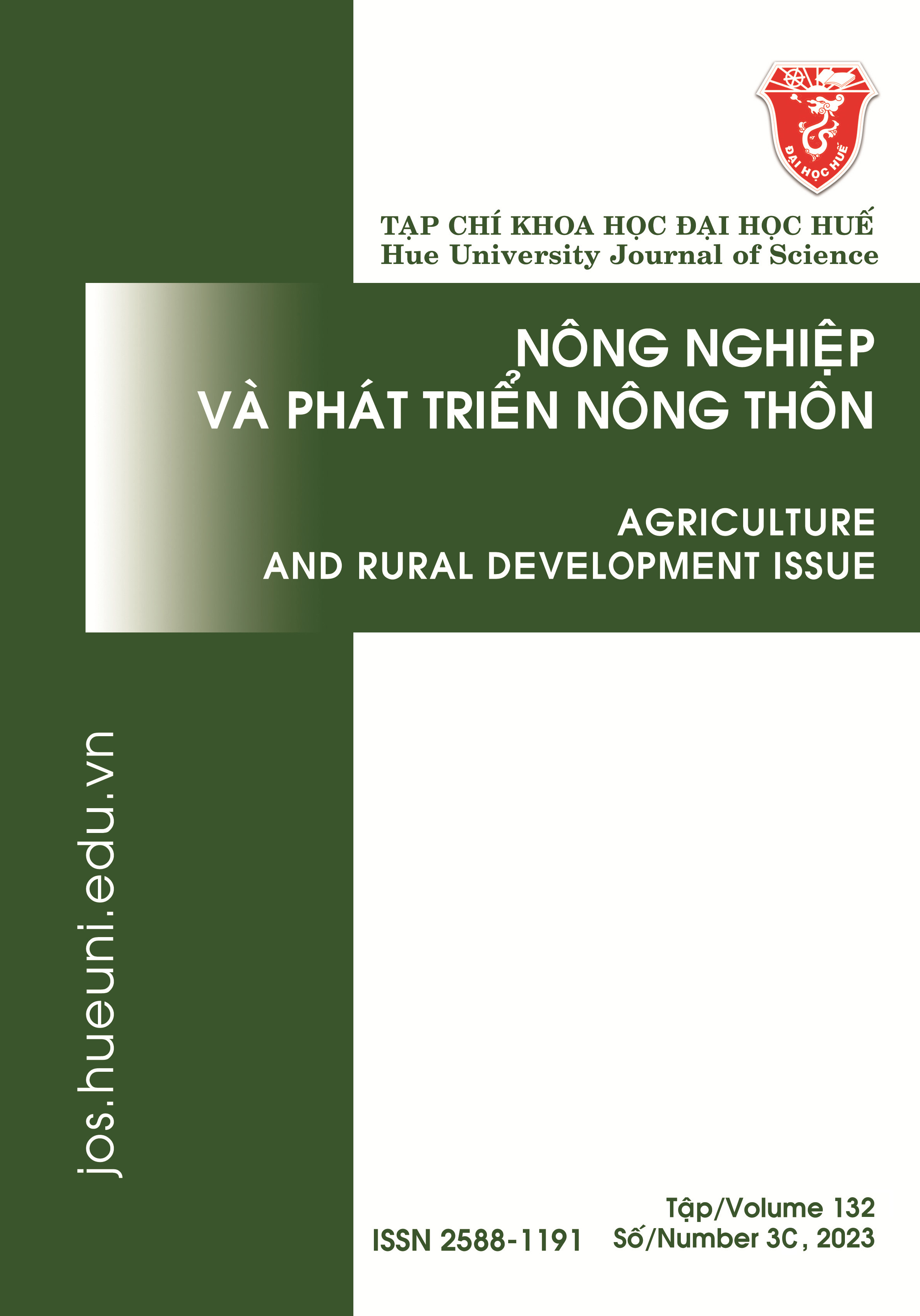Tóm tắt
This paper evaluates the level of suitability of applying GIS, EuroSAT dataset, and Convolutional Neural Networks to recognize residential land in Thua Thien Hue, Vietnam. We employed EuroSAT dataset to train and validate the ResNet152 model. Then, the assessed model was used to detect residential land in the location. The classification accuracy assessment of the Resnet152 model trained with EuroSAT dataset is based on some metrics, including Overall Accuracy, Recall, Precision and F-score, and the residential land detection accuracy of trained Resnet152 was evaluated by using Overall Accuracy. The results show that the performance of Resnet152 over EuroSAT dataset acquires high quality, with the model's classification accuracy reaching 0.98 and all other metrics greater than 0.9. Besides, the model’s detection accuracy of the Resnet152 model and the ground-truth data is as high as 0.88. The most incorrect detection occurs between residential land and two other lands, namely industrial land and herbaceous vegetation. Finally, it is undeniable that this EuroSAT-based ResNet152 model has significant potential to apply in the central region of Vietnam.
Tài liệu tham khảo
- Rinaldi, Laura, Vincenzo Musella, Annibale Biggeri, and Giuseppe Cringoli (2006), New insights into the application of geographical information systems and remote sensing in veterinary parasitology, Journal of Geospatial health, 1(1), 33–47.
- Tuia, Devis, Claudio Persello, and Lorenzo Bruzzone (2016), Domain Adaptation for the Classification of Remote Sensing Data: An Overview of Recent Advances, IEEE Geoscience and Remote Sensing Magazine, 4(2), 41–57. doi: 10.1109/mgrs.2016.2548504.
- Amorós-López, Julia, Luis Gómez-Chova, Luis Alonso, Luis Guanter, Raúl Zurita-Milla, José Moreno, and Gustavo Camps-Valls (2013), Multitemporal fusion of Landsat/TM and ENVISAT/MERIS for crop monitoring, International Journal of Applied Earth Observation and Geoinformation, 23, 132–41. doi: 10.1016/j.jag.2012.12.004.
- Pacifici, F., Longbotham, N., and Emery, W. J. (2014), The Importance of Physical Quantities for the Analysis of Multitemporal and Multiangular Optical Very High Spatial Resolution Images, IEEE Transactions on Geoscience and Remote Sensing, 52(10), 6241–56. doi: 10.1109/TGRS.2013.2295819.
- Walker, J. J., de Beurs K. M., Wynne, R. H., and Gao, F. (2012), Evaluation of Landsat and MODIS data fusion products for analysis of dryland forest phenology, Remote Sensing of Environment, 117, 381–93. doi: 10.1016/j.rse.2011.10.014.
- Yassine, H., K. Tout, and M. Jaber (2021), Improving Lulc Classification from Satellite Imagery Using Deep Learning – Eurosat Dataset, The International Archives of the Photogrammetry, Remote Sensing and Spatial Information Sciences XLIII-B3-2021, 369–76. doi: 10.5194/isprs-archives-XLIII-B3-2021-369-2021.
- Meng, X. L., Nate Currit, Le Wang, Yang, X. J. (2012), Detect residential buildings from lidar and aerial photographs through object-oriented land-use classification, Photogrammetric Engineering RS and Remote Sensing, 78(1), 35–44.
- Al-Dail, M. A. (1998), Change Detection in Urban Areas using Satellite Data, Journal of King Saud University - Engineering Sciences, 10(2), 217–27. doi: 10.1016/s1018-3639(18)30697–4.
- Estoque, Ronald C, and Yuji (2015), Classification and change detection of built-up lands from Landsat-7 ETM+ and Landsat-8 OLI/TIRS imageries: A comparative assessment of various spectral indices, Journal of Ecological indicators Murayama, 56, 205–17.
- Ezimand, Keyvan, AA Kakroodi, and Majid (2018), The development of spectral indices for detecting built-up land areas and their relationship with land-surface temperature, Journal of International journal of remote sensing Kiavarz, 39(23), 8428–49.
- Zhu, X. X., Tuia, D., Mou, L., Xia, G. S., Zhang, L., Xu, F. and Fraundorfer, F. (2017), Deep Learning in Remote Sensing: A Comprehensive Review and List of Resources, IEEE Geoscience and Remote Sensing Magazine, 5(4), 8–36. doi: 10.1109/MGRS.2017.2762307.
- Li, Ying, Haokui Zhang, Xizhe Xue, Yenan Jiang, and Qiang Shen (2018), Deep learning for remote sensing image classification: A survey, WIREs Data Mining and Knowledge Discovery, 8(6), e1264. doi: 10.1002/widm.1264.
- Liu, F., L. Jiao, Tang, X., Yang, S., Ma, W. and Hou, B. (2019), Local Restricted Convolutional Neural Network for Change Detection in Polarimetric SAR Images, IEEE Transactions on Neural Networks and Learning Systems, 30(3), 818–33, doi: 10.1109/TNNLS.2018.2847309.
- Russakovsky, Olga, Jia Deng, Hao Su, Jonathan Krause, Sanjeev Satheesh, Sean Ma, Zhiheng Huang, et al. (2015), ImageNet Large Scale Visual Recognition Challenge, International Journal of Computer Vision, 115(3), 211–52. doi: 10.1007/s11263-015-0816-y.
- Helber, Patrick, Benjamin Bischke, Andreas Dengel, and Damian Borth (2017), EuroSAT: A Novel Dataset and Deep Learning Benchmark for Land Use and Land Cover Classification, doi: 10.1109/JSTARS.2019.2918242.
- Wikipedia (2023), Thừa Thiên Huế province. Accessed 1/26. https://en.wikipedia.org/wiki/Th%E1%BB%ABa_Thi%C3%AAn_Hu%E1%BA%BF_provine.
- Thua Thien Hue People's Committee (2016), Decision No. 950/QD-UBND approving the detailed construction planning (1/2000 scale) of Huong Long area, Hue city, Thua Thien Hue province, Thua Thien Hue.
- Thua Thien Hue People's Committee (2016), Detailed construction planning (1/2000 scale) of Thuy Xuan area, Hue City, Thua Thien Hue province, Thua Thien Hue.
- Thua Thien Hue People's Committee (2016), General planning of Phong An new urban area, Phong Dien district, Thua Thien Hue province to 2030, Thua Thien Hue.
- ESA (2023), Overview of Sentinel-2, https://sentinel.esa.int/web/sentinel/missions/sentinel-2.
- Grivei, A. C., Neagoe, I. C., Georgescu, F. A., Griparis, A., Vaduva, C., Bartalis, Z. and Datcu, M. (2020), Multispectral Data Analysis for Semantic Assessment—A SNAP Framework for Sentinel-2 Use Case Scenarios, IEEE Journal of Selected Topics in Applied Earth Observations and Remote Sensing, 13, 4429–42. doi: 10.1109/JSTARS.2020.3013091.
- Nguyen, Long D., Dongyun Lin, Zhiping Lin, and Jiuwen Cao (2018), Deep CNNs for microscopic image classification by exploiting transfer learning and feature concatenation, IEEE International Symposium on Circuits and Systems (ISCAS), 1–5.
- Szegedy, Christian, Sergey Ioffe, Vincent Vanhoucke, and Alexander Alemi (2017), Inception-v4, inception-resnet and the impact of residual connections on learning, Paper presented at the Proceedings of the AAAI conference on artificial intelligence.
- Fathololoumi, S., Firozjaei, M. K., Li, H. and Biswas, A. (2022), Surface biophysical features fusion in remote sensing for improving land crop/cover classification accuracy, Sci Total Environ, 838 (Pt 3), 156520. doi: 10.1016/j.scitotenv.2022.156520.
- Russell G. Congalton (1991), A Review of Assessing the Accuracy of Classifications of Remotely Sensed Data, Journal of Remote. Sens. Environ, 37, 35–46.
- Mehmet Akif Günen (2021), Performance comparison of deep learning and machine learning methods in determining wetland water areas using EuroSAT dataset, Environmental Science and Pollution Research (2022), 29, 21092–21106, doi: 10.1007/s11356-021-17177-z.
